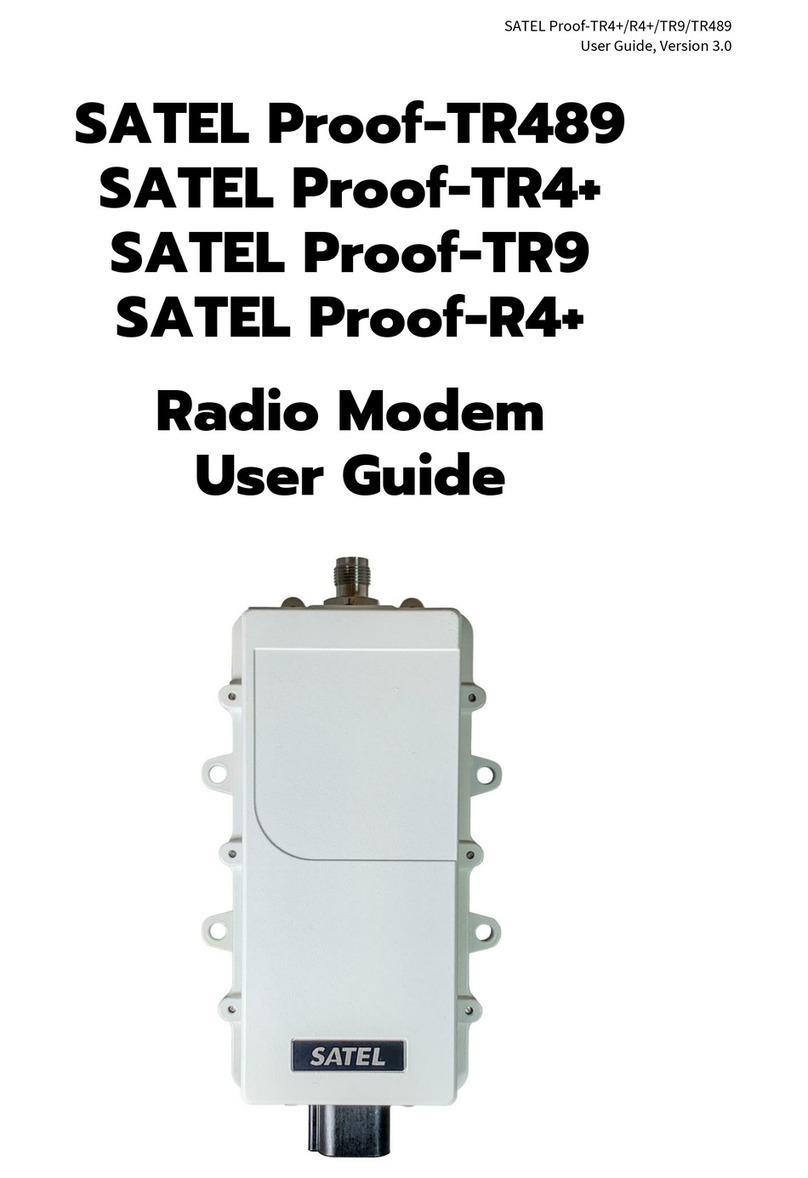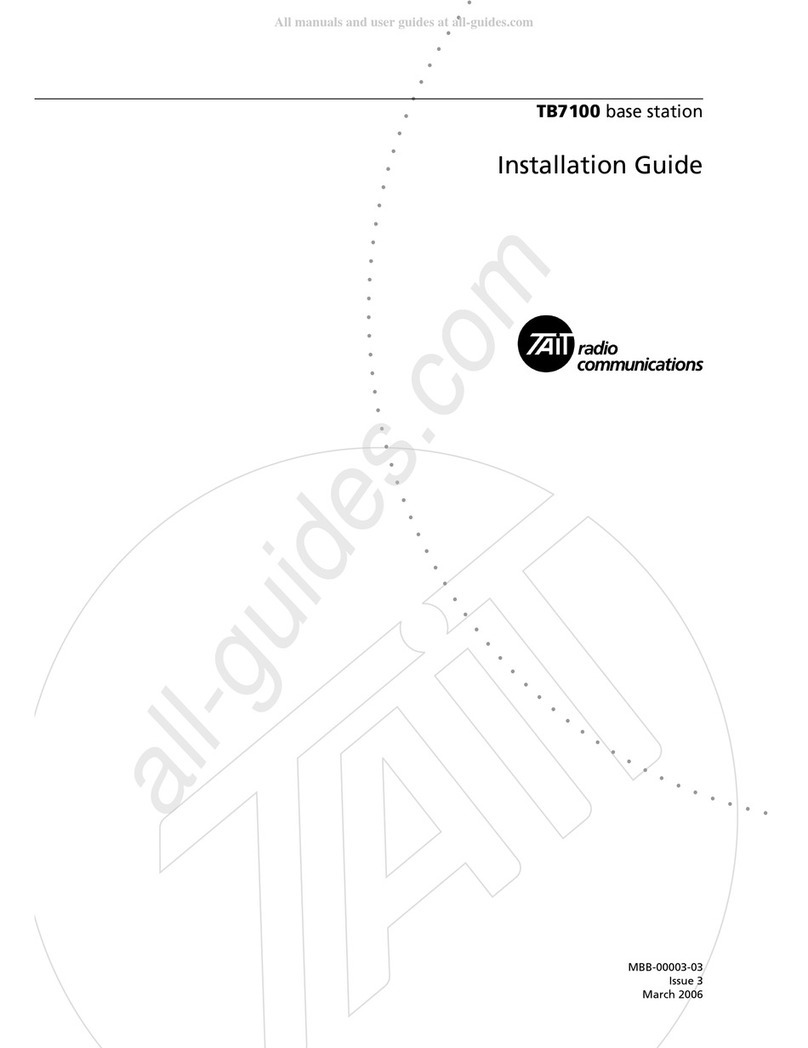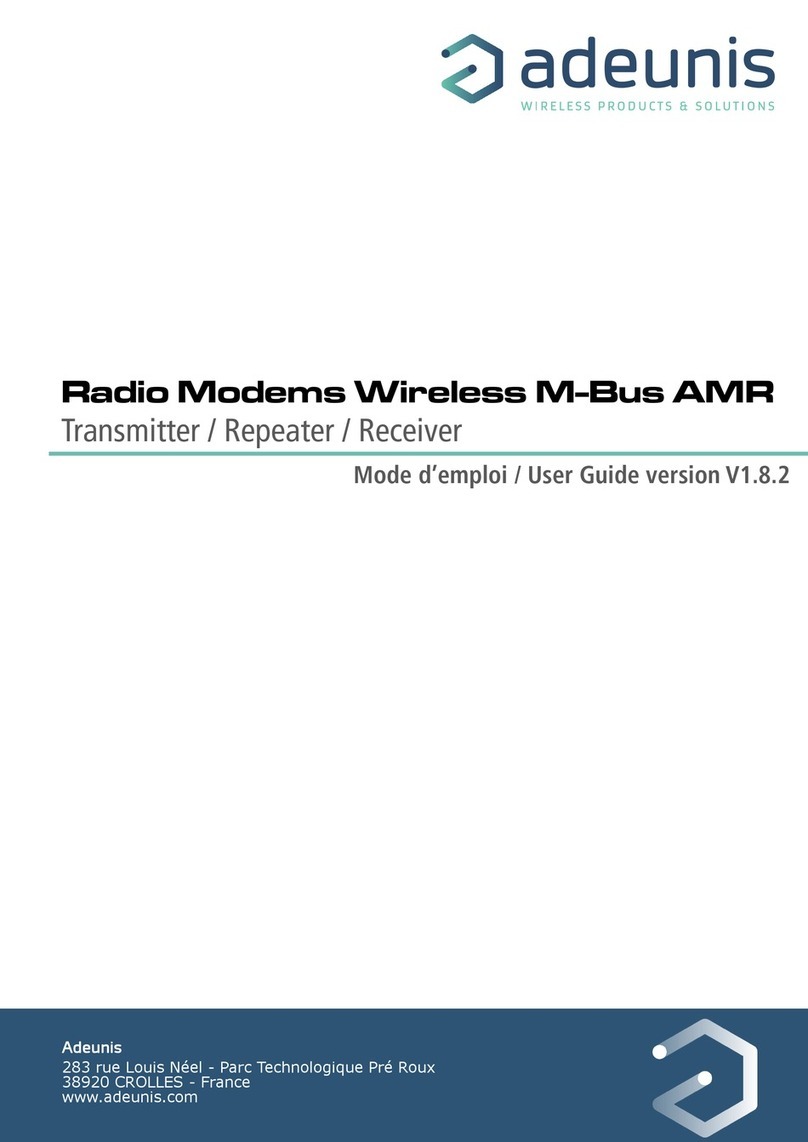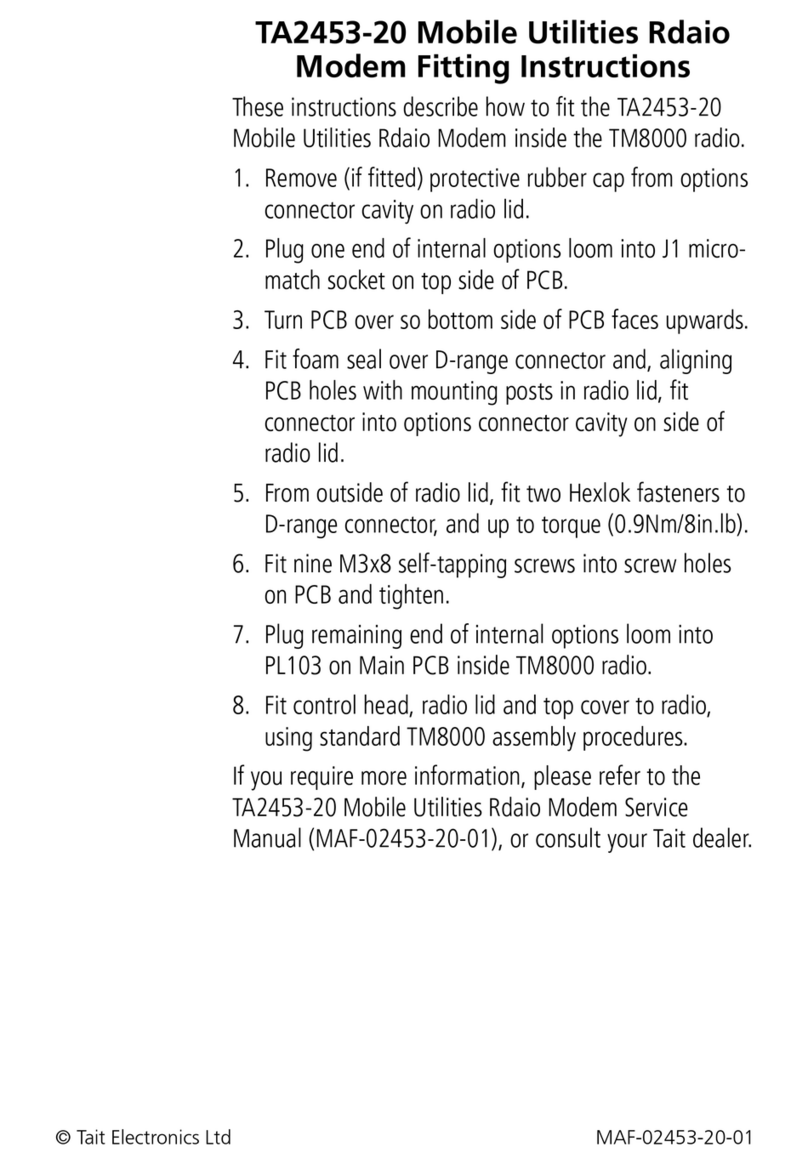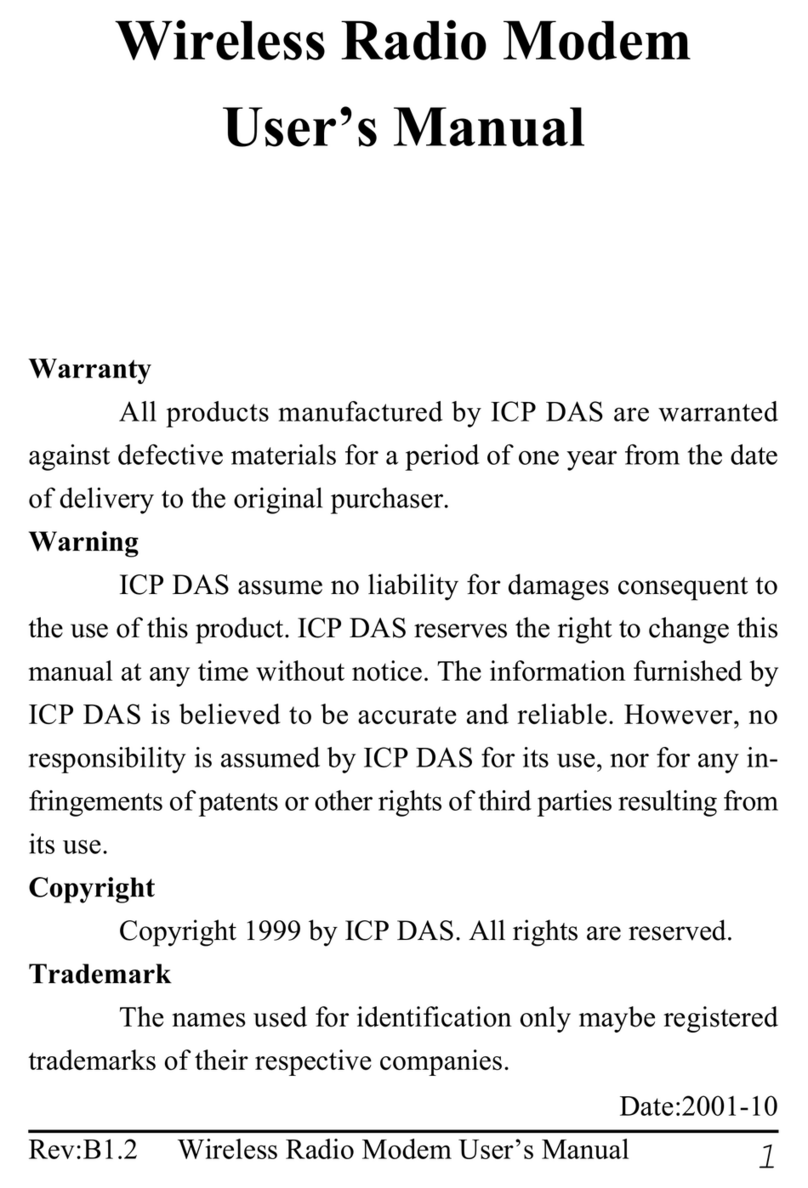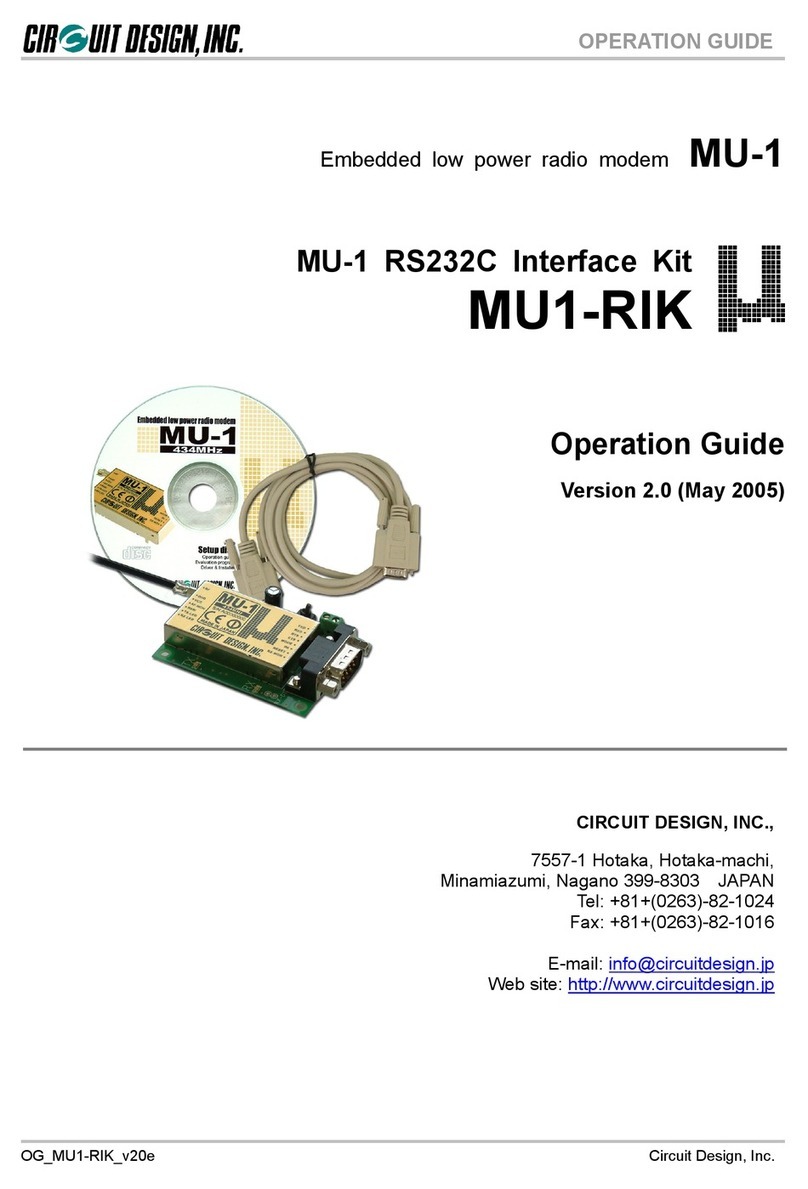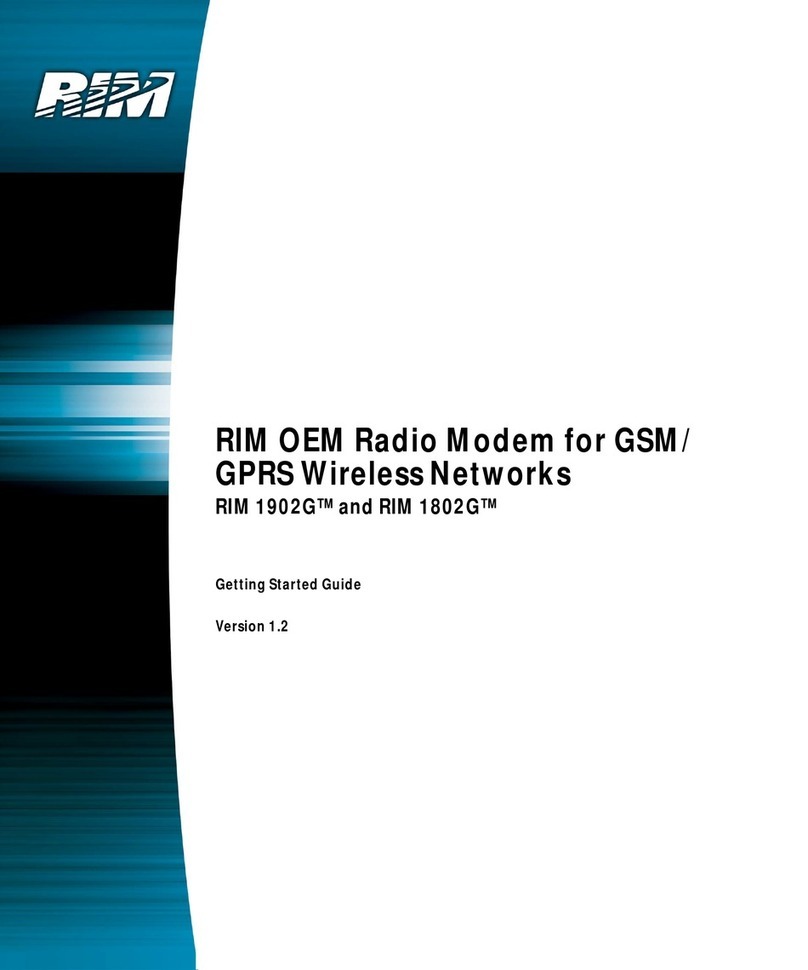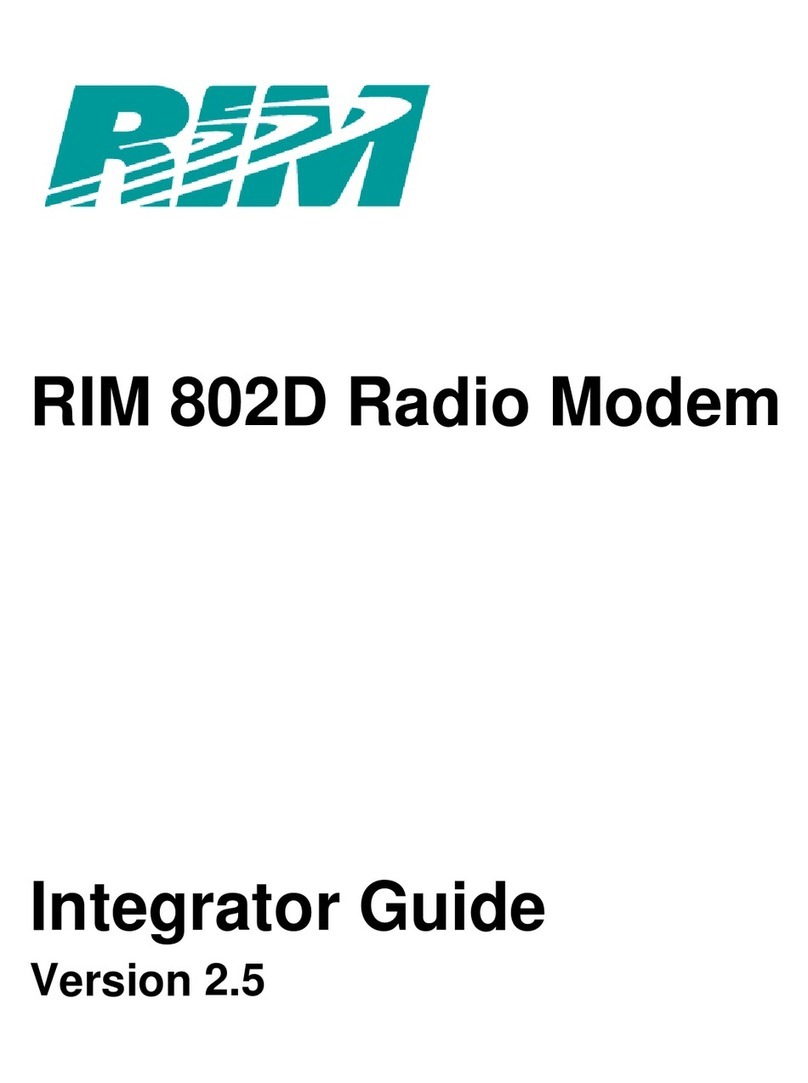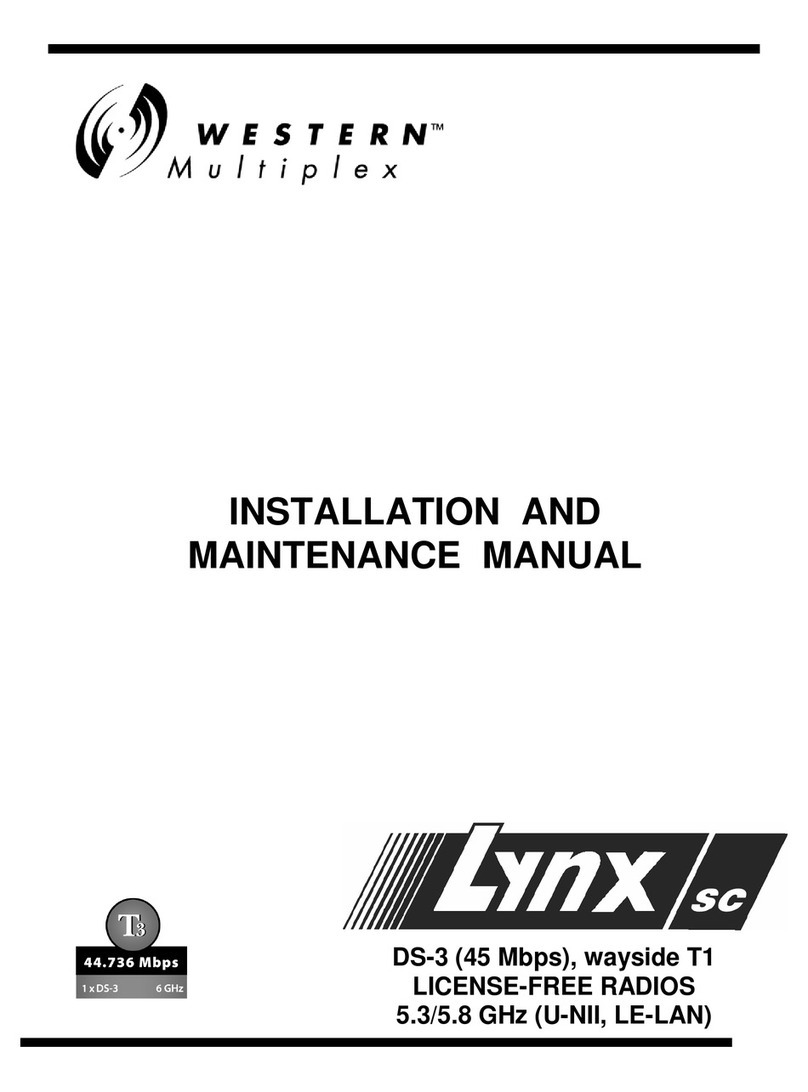FF-Automation WSN169 User manual

WSN Manual Page 1 of 34 Rev. G –4 March 2007
WSN SERIES
RADIO MODEMS
SETUP, INSTALLATION
&
OPERATING MANUAL

WSN Manual Page 2 of 34 Rev. G –4 March 2007
CONTENTS
1INTRODUCTION.....................................................................................3
1.1 PRODUCTS COVERED ....................................................................................................3
1.2 IMPORTANT NOTICES.....................................................................................................3
2PRODUCT OVERVIEW..........................................................................4
2.1 GENERAL..........................................................................................................................4
2.2 TRANSMITTER.................................................................................................................. 4
2.3 RECEIVER......................................................................................................................... 4
2.4 MPU CONTROL................................................................................................................. 5
2.5 PROGRAMMING & CONFIGURATION............................................................................. 5
2.6 SOFT MODEM:..................................................................................................................5
2.7 MODES OF OPERATION..................................................................................................5
2.8 HANDSHAKING................................................................................................................. 5
2.9 ADDITIONAL FEATURES .................................................................................................5
3SPECIFICATIONS..................................................................................7
3.1 TECHNICAL SPECIFICATIONS........................................................................................ 7
3.2 APPROVALS AND LICENSING......................................................................................... 9
4PRE-PROGRAMMED CHANNEL PLANS ...........................................10
4.1 UK MPT1411/VNS2111 CHANNELS.............................................................................. 10
4.2 UK MPT1329 CHANNELS............................................................................................... 12
5SETUP & INTERFACING.....................................................................13
5.1 INTERNAL CONSTRUCTION.......................................................................................... 13
5.2 INTERFACE PORT PIN CONNECTIONS ....................................................................... 13
5.3 12VDC POWER............................................................................................................... 15
5.4 ANTENNA PORT............................................................................................................. 15
5.5 CHANNEL SWITCHES.................................................................................................... 15
5.6 PROGRAMMING............................................................................................................. 15
5.7 RF POWER...................................................................................................................... 15
5.8 TIME-OUT-TIMER ........................................................................................................... 15
5.9 INTERNAL MODEM......................................................................................................... 16
5.10 RADIO DATA FORMATS................................................................................................. 16
5.11 FORWARD ERROR CORRECTOR................................................................................. 17
5.12 SQUELCH TAIL (DRIBBLE BITS) ELIMINATION............................................................ 17
5.13 SERIAL INTERFACE & HANDSHAKING ........................................................................ 17
5.14 TRAFFIC PROTOCOL & ROUTING MODES.................................................................. 19
5.15 TRANSMIT & RECEIVE TIMING..................................................................................... 20
5.16 POWER CONSUMPTION................................................................................................ 23
5.17 POWER SAVE MODE..................................................................................................... 23
5.18 “RSSI” RECEIVE SIGNAL STRENGTH INDICATION..................................................... 23
5.19 STATUS LEDS................................................................................................................. 24
6STORE & FORWARD...........................................................................25
6.1 STORE & FORWARD BASED ON CLIENT PROTOCOL................................................ 25
6.2 MODBUS ......................................................................................................................... 25
6.3 RFT ROUTING PROTOCOL............................................................................................ 27
7INSTALLATION....................................................................................30
7.1 INTRODUCTION.............................................................................................................. 30
7.2 POWER SUPPLIES......................................................................................................... 30
7.3 EFFECTIVE RADIATED POWER (ERP)......................................................................... 30
7.4 ANTENNAS, COAX FEEDERS & PERIPHERALS.......................................................... 31
7.5 MOUNTING & INSTALLATION........................................................................................ 33
7.6 FIXING DETAILS............................................................................................................. 33

WSN Manual Page 3 of 34 Rev. G –4 March 2007
1 INTRODUCTION
1.1 PRODUCTS COVERED
This manual covers the WSN Series of low cost, high performance radio modems designed for
data applications in commercial and industrial systems.
The WSN is an advanced, simplex/half-duplex, data radio for transmission of serial data.
Versions are available with three different serial port configurations:-
A true RS232 interface full handshaking.
As above but with 5V TTL voltage levels on the interface rather than RS232 levels.
An RS232/RS422/RS485 interface with software selection of required mode. (RTS/CTS
and DSR/DTR Handshaking lines looped back to each other in RS232 mode)
Information is provided to assist with configuration, installation, and operation of the products in
point to point or point to multi-point applications. A separate programming manual covers the
use of the associated WinA4P software for programming and configuration of the radios.
Component level servicing is not covered in this document; if the product fails its first line testing
it should be returned to a service centre.
1.2 IMPORTANT NOTICES
1.2.1 Copyright
All rights to this manual are the sole property of FF-Automation Oy The copying of the manual
in whole or in part by any method without written permission is strictly prohibited.
1.2.2 Right To Change
In the interest of improvement, R.F. Technologies reserves the right to change the technical
specifications or functions of its product without notice.
1.2.3 Software
FF-Automation Oy software is delivered “as is”. FF-Automation Oy does not grant any kind of
warranty or guarantees on its saleability or it’s suitability for use in specific applications.
Under no circumstances is R.F. Technologies liable for any damages arising from using the
software.
The copyrights relating to all software is the sole property of FF-Automation Oy.
Any coping, editing, translating or modifying is strictly forbidden without prior written consent
from FF-Automation Oy.
1.2.4 Safety Critical Applications
The WSN has not been designed for, nor is it intended for, use in safety critical or life support
applications. No functional warranty is given if the product is used in such applications.
1.2.5 Use
The WSN radio modems have been designed to work on various licensed and license-free
frequency bands in use around the world. In the license-free bands, the user must ensure that
the radio modem is used under the terms & conditions applicable to the use of the bands
concerned.
In licensed bands, the user must obtain permission and the necessary licenses from the
relevant authorities.

WSN Manual Page 4 of 34 Rev. G –4 March 2007
2 PRODUCT OVERVIEW
2.1 GENERAL
The WSN Series has been designed as a range of high specification, low cost radio modems for
stand-alone applications or for integration into OEM products.
Through the use of advanced DSP technology, the design has been optimised for reliability and
low current consumption, making the WSN suitable for operation on remote sites without mains
power.
Applications include security, command & control, data logging, SCADA, telemetry, remote
switching or any similar applications where serial data needs to be transmitted.
The WSN is available with three different serial interfaces:-
An RS232 interface with all signalling lines to allow full handshaking if required.
A TTL version of the unit, which uses 5V TTL voltage, levels on the serial interface
connector rather than RS232 signalling levels, but is otherwise the same.
A version with an RS232/RS422/RS485 interface. Required interface mode is selected
using the configuration software. In RS232 mode, the RTS line is looped back to CTS
and the DSR line is looped back to DSR. RS422/RS485 half-duplex (2-wire) or full
duplex (4-wire) modes are both supported.
The data rate on the serial interface can set to a range of values from 150 baud to 38,400 baud,
while the over-air data rate can be independently set to a range of values between 150 baud
and 9,600 baud. If high throughput speeds are not required, the modem can be set to a slower
over-air rate to take advantage of the associated improvement in receiver threshold.
The WSN is available with two different transmit powers. The low power version meets the
licence-exempt ETS300-220 specification while the higher power 5W version meets the tougher
ETS300-113 and the USA and Canadian specifications.
2.2 TRANSMITTER
The transmitter frequency can be user programmed anywhere within it’s pre-aligned bandwidth.
There are two power versions available, 10mW to 750mW and 50mW to 5W. The transmit
power of any particular hardware version can be set accurately within the relevant range under
software control.
2.3 RECEIVER
The receiver is a very low current double conversion superheterodyne with an active balanced
mixer for very good intermodulation performance. Careful attention to spurious response,
adjacent channel and blocking performance, makes the product ideal for crowded telemetry
channels.
To achieve high performance the programmable bandwidth of the receiver has been limited (for
UHF it is 10MHz, + 5MHz from centre frequency), full details are in the technical specification
section.
Should re-alignment be required, the unit can be returned to our service centre.

WSN Manual Page 5 of 34 Rev. G –4 March 2007
2.4 MPU CONTROL
The Microprocessor (MPU) is the heart of the product and at the centre is a 128k flash
microprocessor that controls all the interface circuits to the radio module and external
input/outputs. As well as the control function, the processor provides DSP functionality that
enables modem operation between 150 and 9,600bps. The processor has 128k of flash
memory from which the code is executed and internal EEPROM for storing programmed
parameters.
2.5 PROGRAMMING & CONFIGURATION
The parameters of the WSN are PC programmable via the serial port. Full details of all the
programmable parameters are covered in the separate programming manual. Details of cables
and adaptors needed for the various interface versions are given in Section 5.6.
2.6 SOFT MODEM:
The WSN has a “soft modem” which allows over-air transmission at rates between 150bps and
9,600bps using a range of different modulation schemes. The over-air rate can be selected by
the operator to optimise link performance.
2.7 MODES OF OPERATION
2.7.1 Transparent Operation
The WSN can operate transparently without packetising the data and without adding any other
overheads, thereby maximising data throughput rates. It requires no knowledge of the data it is
transmitting. Data is simply transmitted and received with minimal delay.
2.7.2 Protocol specific modem
The radio recognises a complete frame and only transmits and receives data conforming to that
format. No addressing of radios or routing of data is performed. Protocols such as MODBUS &
DNP3 can be supported in this way.
2.7.3 Routing modem
The radios recognise a protocol specific frame and the address to which the frame is to be sent.
Routing information must be stored in each radio for each destination address that requires the
use of repeaters. Any radio in the system can operate as a repeater. The radio does not
perform any acknowledgement or retries. Any protocol using a fixed address field such as
MODBUS can be supported.
2.8 HANDSHAKING
On the RS232 Full Handshaking and TTL versions, transmission control can either use RTS
control signals or be configured for automatic initiation of transmission on receipt of serial data
at the traffic interface. In either case, the radio provides a CTS output, which can optionally be
used for flow control.
On the RS232/RS422/RS485 version, transmission is automatic when transmit data is applied.
The DSR line is internally looped back to DSR and, when configured for RS232 mode, the RTS
line is also looped back to CTS.
In all versions, the radio incorporates a 1,024 byte internal buffer to cope with situations where
the interface data rate is higher than the over-air rate.
2.9 ADDITIONAL FEATURES
The WSN incorporates the following additional features which enhance the usability of the
product and assist with the operation and maintenance of systems using the product:-
2.9.1 Status LEDs:
The WSN Radio Modems have a number of front panel LED’s to enable the operator to see at a

WSN Manual Page 6 of 34 Rev. G –4 March 2007
glance the status of the product and the serial data port.
2.9.2 Time-out Timer
The transmitter within the WSN has a user programmable time-out timer which allows the
maximum continuous transmission time to be set in order to prevent channel blocking due to a
fault.
2.9.3 Power-Save Modes
The WSN has both internally controlled and externally controlled power-save modes to reduce
overall power consumption to extremely low levels for operation on sites without mains power.
2.9.4 Squelch Tail Elimination
As a user programmable option, the WSN can also operate in a packetisation mode where
framing characters are added at the start and end of the user's message prior to transmission
and stripped off again at the receive end prior to passing the user data to the interface
connector. This can be useful in getting rid of any spurious characters which may otherwise be
generated at the end of messages by squelch noise as the receiver mutes and which can affect
old or non-tolerant protocols.
In a high interference environment, enabling packetisation will often help to block reception of
the interfering signals.
2.9.5 Forward Error Correction
The WSN allows an optional forward error correction to be switched in when the over-air data
rate is 9,600bps. This will improve error performance, but there is an associated data
throughput overhead of around 30%, which therefore reduces the effective transmission rate for
the user data. The forward error corrector is not available at lower data rates, as it offers no
significant performance enhancement at these lower rates.

WSN Manual Page 7 of 34 Rev. G –4 March 2007
3 SPECIFICATIONS
3.1 TECHNICAL SPECIFICATIONS
3.1.1 General
Frequency Range: WSN169/170 138 - 175MHz
WSN225 175 - 225MHz
WSN450/470 406 - 512MHz
WSN869 869 - 870MHz
(50MHz –950MHz to special order)
Power Requirements: 12VDC (10V –15.5DC)
Standby: <75uA
Receiver on & decoding: <70mA
Transmitting: 300mA to 2.1A dependent on Tx power
Number of Channels: 80 sequential or 32 discrete user programmable channels.
Min. Programmable
Channel Step: 6.25kHz or 5kHz
Channel Spacing: 12.5kHz, 20kHz or 25kHz
Operating Temp.
Stability: 2ppm –30 to +60ºC
Construction: Aluminium enclosure.
Size: 75mm W x 130mm L x 30mm H (excluding brackets and connectors)
Mounting: Screws to a flat surface.
Weight: 250g
Connectors: DC Power 2-way Klippon Type
Serial Data 9-way D-Type Female
RF BNC (50 ohm)
LED Indicators: TX, Busy, System, RXD, TXD
3.1.2 Transmitter:
RF Output Power: WSN 169/450/869 10mW - 750mW
WSN 170/225/470 50mW - 5Watts
Bandwidth: VHF 10MHz without re-alignment
UHF 12MHz without re-alignment
869 30MHz without re-alignment
Internal Modulation: Programmable for FFSK, 2-Level FSK, GMSK or 4-Level FSK.
Max. Deviation: ± 7.5kHz max
Duty Cycle up to 70%
Adj. Channel Power: >65dB at 12.5kHz
Spurious Emissions: As per ETS300-113
Rise Time: < 9mS
3.1.3 Receiver
Sensitivity: 0.25uV (-119dBm) for 12dB SINAD de-emphasised
0.355uV (-117dBm) for 12dB SINAD flat
Bandwidth: VHF 5MHz without re-alignment
UHF 10MHz without re-alignment

WSN Manual Page 8 of 34 Rev. G –4 March 2007
869 20MHz without re-alignment
Spurious Response: WSN 169/450/869 >65dB
WSN 170/225/470 >70dB
Blocking: WSN 169/450/869 >85dBuV
WSN 170/225/470 >90dBuV
Intermodulation: WSN 169/450/869 >60dB (3 Signal)
WSN 170/225/470 >65dB (3 Signal)
Adjacent Channel: >65dB at 12.5kHz
IF Frequencies: 45MHz and 455kHz
Spurious Emissions: WSN 169/450/869 <ETS 300-220
WSN 170/225/470 <ETS 300-113
Mute Response Time: <2msec
3.1.4 Internal Modem
Serial Comms: Asynchronous (or Synchronous with custom software).
Baud rate programmable between 150bps and 38,400bps
Interface: /232Full version :- RS.232 complete with signalling lines
/TTL version:- 5V TTL levels rather than RS.232
/232+485 version:- RS.422/RS.485 (2 or 4 wire) or
RS232 with looped back signalling lines.
Parity: Programmable as Odd, Even or None
NRZI: On or Off
Stop bits: Programmable 1 or 2
Data Bits: Programmable 7 or 8
Signalling Formats: Programmable as V23, Bell202 or MPT1327, up to 1200 baud, coherent
FFSK at 2400 baud, GMSK at 4800 baud, 4 Level FSK at 9600 baud.
Synchronous/Async. Programmable as either up to 1200bps, synchronous above 1200bps
Over-air Baud Rate: 150 –9600bps within 12.5kHz
Bit Error Rate: 150 - 2400 baud less than 1 x 10-3 at –120dBm
4800 baud less than 1 x 10-3 at –117dBm
9600 baud less than 1 x 10-3 at –115dBm (FEC on)
9600 baud less than 1 x 10-3 at –112dBm (FEC off)
Forward Error Corrector (FEC) is a programmable option at 9600bps.
The bit error rates quoted above are for fixed messages representing
typical data sent over the link. The BER should not be directly compared
with other manufactures figures unless the data format is known, as
many manufacturers quote a BER based on a simple alternating data
pattern, which will generally give much better BER results.

WSN Manual Page 9 of 34 Rev. G –4 March 2007
3.2 APPROVALS AND LICENSING
The WSN has been designed to meet the relevant standards outlined below. Should others be
required, please contact the sales office.
3.2.1 UK Approvals
MPT1411/VNS2111: The 5W version of the WSN has been tested to MPT1411 and the
replacement VNS2111 for licensed applications with a maximum data
rate of 9600bps within a 12.5 kHz channel. A licence is required and the
permitted output power is normally stated on the licence.
MPT1329: The radios meet the requirements of MPT1329
BS2011: The unit complies with the Vibration specification BS2011.
3.2.2 European Approvals
ETS 300-220 The unit meets the specification for European licensed exempt
communications with a maximum RF power level of 500mW. Please
note the permitted power level may vary from country to country.
ETS 300-113 The 5W version of the unit meets the specification for licensed data
radios
ETS 301-489: The unit meets the required CE specification and carries a CE Mark.
EN60950 The unit meets the relevant requirements of this Safety specification.
3.2.3 European Declaration of Conformance
Hereby, FF-Automation Oy declares that the WSN Series of Radio Modems is in compliance
with the essential requirements and other relevant provisions of Directive 1999/5/EC.
In the interest of improvement the above specifications are subject to change without notice.

WSN Manual Page 10 of 34 Rev. G –4 March 2007
4 PRE-PROGRAMMED
CHANNEL PLANS
Using the PC configuration software, the WSN can be programmed with a number of standard
channel plans. These currently include all UK MPT1411 or MPT1329 channels. Further
standard channel plans may become available in later releases of the configuration software. A
mixture of channels from different channel plans can also be entered discretely using the
software.
The following tables show the channel numbers and associated frequencies for various channel
plans:-
4.1 UK MPT1411/VNS2111 CHANNELS
CHANNEL
SCANNER
OUTSTATIONS
1
457.50625
463.00625
2
457.51875
463.01875
3
457.53125
463.03125
4
457.54375
463.04375
5
457.55625
463.05625
6
457.56875
463.06875
7
457.58125
463.08125
8
457.59375
463.09375
9
457.60625
463.10625
10
457.61875
463.11875
11
457.63125
463.13125
12
457.64375
463.14375
13
457.65625
463.15625
14
457.66875
463.16875
15
457.68125
463.18125
16
457.69375
463.19375
17
457.70625
463.20625
18
457.71875
463.21875
19
457.73125
463.23125
20
457.74375
463.24375
21
457.75625
463.25625
22
457.76875
463.26875
23
457.78125
463.28125
24
457.79375
463.29375
25
457.80625
463.30625
26
457.81875
463.31875
27
457.83125
463.33125
28
457.84375
463.34375
29
457.85625
463.35625
30
457.86875
463.36875
31
457.88125
463.38125
32
457.89375
463.39375
33
457.90625
463.40625
34
457.91875
463.41875
35
457.93125
463.43125
36
457.94375
463.44375
37
457.95625
463.45625
38
457.96875
463.46875
39
457.98125
463.48125
40
457.99375
463.49375
41
458.00625
463.50625
42
458.01875
463.51875
43
458.03125
463.53125
44
458.04375
463.54375

WSN Manual Page 11 of 34 Rev. G –4 March 2007
45
458.05625
463.55625
46
458.06875
463.56875
47
458.08125
463.58125
48
458.09375
463.59375
49
458.10625
463.60625
50
458.11875
463.61875
51
458.13125
463.63125
52
458.14375
463.64375
53
458.15625
463.65625
54
458.16875
463.66875
55
458.18125
463.68125
56
458.19375
463.69375
57
458.20625
463.70625
58
458.21875
463.71875
59
458.23125
463.73125
60
458.24375
463.74375
61
458.25625
463.75625
62
458.26875
463.76875
63
458.28125
463.78125
64
458.29375
463.79375
65
458.30625
463.80625
66
458.31875
463.81875
67
458.33125
463.83125
68
458.34375
463.84375
69
458.35625
463.85625
70
458.36875
463.86875
71
458.38125
463.88125
72
458.39375
463.89375
73
458.40625
463.90625
74
458.41875
463.91875
75
458.43125
463.93125
76
458.44375
463.94375
77
458.45625
463.95625
78
458.46875
463.96875
79
458.48125
463.98125
80
458.49375
463.99375

WSN Manual Page 12 of 34 Rev. G –4 March 2007
4.2 UK MPT1329 CHANNELS
The WSN can be programmed to operate on the full MPT1329 band of channels with access to
channels 26, 27 & 32 denied, in line with MPT1329 band plan.
The radio should be programmed for a maximum power level of 500mW.
CHANNEL
FREQUENCY
1
458.5000 Guard Ch.
2
458.5125
3
458.5250
4
458.5375
5
458.5500
6
458.5625
7
458.5750
8
458.5875
9
458.6000
10
458.6125
11
458.6250
12
458.6375
13
458.6500
14
458.6625
15
458.6750
16
458.6875
17
458.7000
18
458.7125
19
458.7250
20
458.7375
21
458.7500
22
458.7625
23
458.7750
24
458.7875
25
458.8000
26
458.8125
27
458.8250 Not Used
28
458.8375 Not Used
29
458.8500
30
458.8625
31
458.8750
32
458.8875
33
458.9000 Not Used
34
458.9125
35
458.9250
36
458.9375
37
458.9500 Guard Ch.

WSN Manual Page 13 of 34 Rev. G –4 March 2007
5 SETUP & INTERFACING
5.1 INTERNAL CONSTRUCTION
The exploded view shows the main components of the radio modem. There are no user
adjustments or settings, which require removal of the covers.
5.2 INTERFACE PORT PIN CONNECTIONS
The WSN Series is equipped with a 9 way female D connector for the traffic interface. The pins
of this connector are allocated as follows:-
5.2.1 RS232-Only (Full Handshaking) and 5V TTL versions
1. DCD: Data Carrier Detect - - - o
2. RXD: Receive Data - - - - - - -
o- - - - - 6. DSR: Data Set Ready
o
o- - - - - 7.
3.
o- - - - - 8.
4. DTR: Data Terminal Ready - - o
o- - - - - 9. nc Not Connected
5.
RTS: Request to Send
TXD: Transmit Data - - - - - - - o
CTS: Clear to Send
GND: GROUND - - - - - - - - - - o

WSN Manual Page 14 of 34 Rev. G –4 March 2007
5.2.2 RS232/RS422/RS485 Versions
The RS232/RS422/RS485 versions of the WSN may be software programmed to have either an
RS232 or an RS422/RS485 compatible interface.
To allow programming without an interface adapter, a radio programmed for RS422/RS485
operation will switch back to RS232 operation if the front panel rotary switches are set to
position 00 to select programming mode. Note that although the WSN can withstand RS232
voltages on its inputs in RS422/RS485 mode, this may not be the case for externally connected
devices. To avoid any risk of damage to the externally connected equipment, care must
therefore be taken to ensure that programming mode is not selected while connected to
RS422/RS485 terminal equipment.
Pin allocation when set for RS232 operation:-
o- - - - - 9. nc Not Connected
4. DTR: Data Terminal Ready - - - - - - - o
(Internally connected to Pin 6)
o- - - - - 8. CTS: Clear to Send
(Internally connected to Pin 7)
3. : Transmit Data Input - - - - - - - -TXD o
- - - - - 7. RTS: Request to Send
o(Internally connected to Pin 8)
2. : Receive Data Output - - - - - - - -RXD o
o- - - - - 6. DSR: Data Set Ready
(Internally connected to Pin 4)
5. GND: GROUND - - - - - - - - - - - - - - - o
1. Data Carrier Detect - - - - - - - - -DCD: o
Pin allocation when set for RS422/RS485 operation:-
o- - - - - 9. nc Not Connected
4. DTR: Data Terminal Ready - - - - - - - o
(Internally connected to Pin 6)
o- - - - - 8. *****: Do Not Use
(Internally connected to Pin 7)
3. : +ve Data In to Radio - - - - - - - -TXD + o
- - - - - 7. : -ve Data In to Radio
o TXD - (Internally connected to Pin 8)
2. : -ve Data Out from radio - - - - - -RXD - o
o- - - - - 6. DSR: Data Set Ready
(Internally connected to Pin 4)
5. GND: GROUND - - - - - - - - - - - - - - - o
1. : +ve Data Out from radio - - - - -RXD + o
When half-duplex (2-wire) RS422/RS485 operation is programmed, the TXD- and TXD+ signals
are internally connected to the RXD- and RXD+ signals respectively. The 2-wire half-duplex
bus only needs to be connected to the RXD- and RXD+ pins (Pins 1 and 2). Shorting links are
not required in the connector.
When operating in 2-wire RS422/RS485 mode, the radio will output data on to a 2 wire circuit
whenever it is received, which could lead to a bus conflict in conditions of high interference and
prevent a connected terminal from outputting transmit data. To avoid this condition it is
recommended that the message packeting option is turned on at both ends of the radio link.
The DTR and DSR signals are looped back to each other internally in both configurations.
When configured for RS232 operation, the RTS and CTS signals are also looped back to each
other. The radio should in most circumstances operate correctly in applications requiring
RTS/CTS handshake although the it is unable to use CTS to prevent buffer overflow. Overflow
situations can easily be avoided by making the serial port baud rate the same as the radio
signal baud rate, or by ensuring that message sizes do not exceed the buffer size of 1024
bytes.
The DTR input has a threshold of approximately +1.5V with respect to ground, it may be used
with a standard RS232 level signal or a TTL level signal in either RS232 or RS485 mode, the
signal is active high in both cases.

WSN Manual Page 15 of 34 Rev. G –4 March 2007
5.3 12VDC POWER
A nominal 12VDC (9.6 –15.5Vdc) is supplied to the unit via a 2 way pluggable terminal block,
the polarity is marked on the front panel and the plug has a polarity key to prevent accidental
polarity reversal. In the event of a polarity diodes and fuses protect reversal the circuit board.
5.4 ANTENNA PORT
The antenna connection is a 50-ohm BNC connector. This should be connected to a suitable
antenna or terminated in a 50-ohm load whenever the transmitter is activated. Transmission
into an open circuit may cause excessive current to be drawn from the supply and damage
could occur.
5.5 CHANNEL SWITCHES
The WSN can be user programmed with up to 80 sequential or 32 discrete simplex or semi-
duplex channels.
The two front panel BCD switches select the required channels or, if both are set to zero,
program mode is entered. In program mode, the radio interprets any signals on the serial
interface as programming commands rather than data for transmission.
When viewing a WSN with the aerial connector at the top, the left hand rotary switch is the
"tens" switch and the right is the "units" switch, thus to set channel 37, set the left switch to 3
and the right to 7.
5.6 PROGRAMMING
The parameters of the WSN can be programmed via the serial port using either DOS or
Windows based software. The individual configuration files can be stored on disc for future use
or printed. Full details of all the programmable parameters are covered in the separate
programming manual.
The RS232 Only (Full Handshaking) version can be connected directly to the serial port on a
PC using a straight-through cable.
The 5V TTL version needs an adaptor unit between the WSN and the programming computer to
convert between RS232 and TTL voltage levels.
The RS232/RS422/RS485 version does not need an adaptor because the serial port switches
to RS232 mode automatically when the radio is put into program mode by setting both front
panel switches to zero. A standard straight-through cable with all pins connected may be used
for connection to the PC.
5.7 RF POWER
The transmit power can be accurately set using a locally connected PC running the supplied
configuration software. This allows the RF power level to be programmed directly in Watts or
milliwatts with an accuracy of +/-1dB. There are no internal power adjustment points inside the
modem.
There are two transmit power ranges available. The low power WSN169, WSN450 & WSN869
versions can be set between 10mW and 750mW, while the higher power WSN170, WSN225 &
WSN470 versions can be set between 50mW and 5W.
5.8 TIME-OUT-TIMER
The transmitter within the WSN has a time-out timer, which allows the maximum continuous
transmission time to be set in order to prevent channel blocking due to a host fault. The timer
works in all modes (external/internal modem) and is programmable in one-second steps
between 0 and 255 seconds. If not required the timer can be programmed off.
If the timer is enabled and the selected time is exceeded, transmission will cease until the action
that normally causes transmission is removed and then re-applied. More explicitly, with
RTC/CTS handshake enabled RTS must be dropped and then raised again, or if handshake is
not enabled character transmission must be suspended for at least two character periods at the
serial port baud rate. In all modes the modem’s SYS led is flashed at least twice when time-out
occurs, the flashing continues while lockout is in force. The lockout timer is disabled if the
lockout time is set to 0. The lockout timer can be operated in “resettable” or “cumulative” mode,

WSN Manual Page 16 of 34 Rev. G –4 March 2007
in resettable mode the timer restarts each time a transmission is made, in cumulative mode the
timer counts up during transmit, and down during receive. If the timer counts up to the lockout
time during transmit, lockout occurs; this will eventually happen if the radio spends more than
half of its time transmitting. Lockout in this mode is indefinite and can only be reset by powering
the radio off.
5.9 INTERNAL MODEM
The WSN features an internal “soft modem” which offers unparalleled performance and
flexibility over a wide range of speeds and formats. Data is presented to the modem via the
RS232 (or TTL) serial connection at speeds between 150 and 38400 and then transmitted at
the programmed radio baud rate. Buffering is provided when the data rate is higher than the
radio transmission rate.
5.9.1 Modulation & Tone-sets
Within a 12.5kHz channel, the over-air transmission from the unit can be programmed for a
range of speeds. For 150, 300, 600,1200, the modulation is FFSK with Bell 202 and V.23
(Mode 2) tone-sets both supported. At these lower speeds, it is also possible to select a
protocol specific MPT1327 mode, which uses a 1200/1800Hz tone-set to allow compatibility
with number of additional modems from other manufacturers. At 2400bps the modulation is
coherent FFSK, at 4800bps it is GMSK and at 9600bps it is 4-Level FSK.
If operating at speeds up to and including 1200bps and compatibility with other equipment is not
required, the use of the Bell 202 tone-set is recommended, as this will give the best link
performance.
5.9.2 Synchronous/Asynchronous Modem Operation
The radio modem can be programmed for asynchronous or synchronous operation at baud
rates up to 1200. At baud rates of 2400 or more, modem operation may only be synchronous.
This relates to the over-air signal and has no bearing on the format of the data presented at the
serial interface port
In synchronous mode inverted NRZI encoding is used where a one is represented by a
transition in the binary data, every transmitted bit fits into a time slot defined by the baud rate,
this allows a phase locked loop to lock on to the data stream to give better performance in noisy
conditions, the inverted NRZI encoding allows this to continue even when the signal is idling
sending stop bits. The inverted NRZI encoding gives a further advantage with GMSK signalling
since the polarity of the signal is unimportant.
In asynchronous mode NRZ encoding is used where a “one” tone represents a binary one, and
a “zero” tone a binary zero, whilst each character consists of bits of equal duration defined by
the baud rate, the time between the end of a stop bit and a following start bit may be arbitrary.
This prevents the implementation of a phase locked loop to improve signal to noise
performance but does allow use within older systems that do not implement synchronous
transmission or NRZI encoding.
If compatibility with other radios is not required, the use of the synchronous mode is
recommended, as this will give best link performance.
5.10 RADIO DATA FORMATS
The data rate over the air can be set up independently of the rate set for the serial interface, but
the over-air rate should be set either at the same speed or a lower speed than the serial
interface rate. The radio baud rate should be set at the minimum possible to maintain the
required throughput, lower speeds will give better results in poor signal conditions
The radio signal can be set up to operate using 7 or 8 bit data, 1 or 2 stop bits, and odd, even or
no parity. This setting is also independent of the serial port set up. This flexibility allows
compatibility with other radios.
If the Forward Error Corrector is enabled (option only available at 9,600bps), the selected radio
signal format is over-ridden as detailed below.

WSN Manual Page 17 of 34 Rev. G –4 March 2007
5.11 FORWARD ERROR CORRECTOR
At 9600bps there is also a programmable option to switch in a forward error corrector. When
switched on, the over-air data format changes to a fixed format using 14 bit words. These
comprise 8 data bits, 5 CRC (Cyclic Redundancy Check) bits and a flag bit which is used to
differentiate control and data functions in messages. An additional 14 bit synchronisation word
is also sent after every 8 data words. The effect of this redundancy on a typical 9600bps link
configuration is to reduce the effective data transfer rate to around 6300bps.
The error corrector is aimed at improving performance in weak signal conditions, rather than
recovering data in deep fades or burst-error conditions. An error rate of 1x10-4 with the FEC
switched off will typically improve by a factor of 2000 to around 5 in 10-7 when it is switched on,
but an initial error rate of 1x10-3 with it off will only improve by a factor of around 250 to
something like 4x10-5 when it is switched on.
In terms of receiver sensitivity, the 1x10-6 thresholds improve by around 0.4uV (or 6.4dB) when
the FEC is switched on.
5.12 SQUELCH TAIL (DRIBBLE BITS) ELIMINATION
The WSN has an optional packetisation mode, which can be enabled using the configuration
program. This adds framing characters at the start and end of the user’s message prior to
transmission. The additional information is stripped off the messages at the receiver prior to
passing the data to the interface connector. Packetisation can be useful in getting rid of any
spurious characters which may otherwise be generated at the end of messages by squelch
noise as the receiver mutes or by interference and which can affect old or non-tolerant
protocols.
It is important to note that packetisation must be set the same on all radios operating together.
All radios must have it selected or all radios must have it de-selected.
5.13 SERIAL INTERFACE & HANDSHAKING
5.13.1 Handshaking on RS232/RS422/RS485 version
In this version of the WSN, transmission is automatic when transmit data is applied.
When configured for RS232 mode, the RTS line is looped back to CTS and the DSR line is
looped back to DSR. The radio should in most circumstances operate correctly in applications
requiring RTS/CTS handshake although the it is unable to use CTS to prevent buffer overflow.
Overflow situations can easily be avoided by making the serial port baud rate the same as the
radio signal baud rate, or by ensuring that message sizes do not exceed the buffer size of 1024
bytes.
5.13.2 Handshaking on RS232-Only (Full Handshaking) and TTL versions
The RS232 Only (Full Handshaking) and TTL versions can be programmed either to use
RTS/CTS handshaking to initiate transmission, or to transmit automatically whenever data is
present at the serial input. In the latter mode CTS is still operated to implement flow control but
can be ignored unless message sizes exceed 1k byte and the serial port baud rate is higher
than the radio signal baud rate. These handshaking modes are compatible with modes A, C and
D of the CMD400 manufactured by Pacscom Ltd.. Mode B (byte stuffing mode) is not
supported.
Transmission Using RTS/CTS Handshaking (RS232-Only and TTL Versions):-
If handshaking is enabled, operating RTS starts transmission. CTS can then be monitored for
flow control purposes. In the idle state CTS is inactive, but when RTS is operated CTS will
become active immediately and data may be input to the serial port. When all data has been
loaded to the serial port RTS should be dropped. Transmission will continue until all data in the
serial input buffer has been sent, then CTS will become inactive and transmission will cease.
During transmission the amount of data in the serial buffer is checked by the radio, if the buffer
becomes ¾ full CTS is dropped to request the host to stop loading data, CTS is activated again
when the buffer is reduced to ¼ full. To prevent timing problems data will still be accepted into
the buffer when CTS is de-activated due to buffer filling during transmit, however any data
received once CTS has dropped at the end of a transmission will be discarded, this prevents
such data from being prefixed to the beginning of the next message.

WSN Manual Page 18 of 34 Rev. G –4 March 2007
Transmission Without Hardware Handshaking (RS232-Only and TTL Versions):-
If RTS/CTS handshaking is disabled the radio will start transmission as soon as data is received
at the serial port, transmission ceases as soon as the serial buffer has been emptied and a
period equivalent to two characters at the radio signal baud rate has elapsed. It is important to
note that since transmission ceases as soon as a two-character delay in the incoming data
stream is seen, data characters in a message must be presented in a continuous back-to-back
stream.
In this mode CTS is still used to indicate the serial buffer fill level in the same way as described
in the section on transmission using handshake, the difference is that in the idle state CTS is
always active indicating readiness to accept data. In most applications CTS can be ignored as
messages are likely to be smaller than the serial input buffer (1k byte), bear in mind also that if
the radio baud rate and data format is the same as that configured for the serial port the buffer
is being emptied as fast as it is being filled and so buffer overrun is unlikely.
5.13.3 Data Reception
Any data received by the radio is simply output to the serial port, and in RS232 configurations
the DCD line can be programmed to operate in three different modes to assist the host. Firstly
by indicating that a carrier is detected on the radio channel, this is useful if a busy lockout
function is required (although this can be dangerous if the channel is susceptible to interference
as well as wanted signals), secondly DCD can indicate presence of a carrier and a valid data
signal, data will normally be output under this circumstance, the third mode behaves in the
same way as the second except that DCD remains active until all data has been output to the
serial port after the signal has gone, this allows DCD to be used as a wake up signal.
In RS422 and RS485 2-wire configurations, the radio will output data on to the 2 wire circuit
whenever it is received, which could lead to a bus conflict in conditions of high interference,
preventing any connected terminal from transmitting data when it wants to. To avoid this
condition it is recommended that the message packeting option is turned on at both ends of the
radio link in this mode.

WSN Manual Page 19 of 34 Rev. G –4 March 2007
5.14 TRAFFIC PROTOCOL & ROUTING MODES
5.14.1 Transparent Mode
In this mode, the radio has no knowledge of the data it is transmitting, data is simply transmitted
and received under hardware control with the option of RTS control or initiation of transmit after
receiving serial data, with CTS providing an optional flow control. This configuration is useful
when expanding older systems where the radios must be compatible with other manufacturers
equipment.
5.14.2 Protocol Specific Mode
The radio recognises a complete frame and only transmits and receives data conforming to that
format. No addressing of radios or routing of data is performed. Protocols such as MODBUS
can be supported in this way.
5.14.3 Routing Mode
The radios recognise a protocol specific frame and the address to which the frame is to be sent.
Routing information must be stored in each radio for each destination address that requires the
use of repeaters or store & forward nodes. Any radio in the system can operate as a
repeater/store & forward node. The radio does not perform any acknowledgement or retries.
Any protocol using a fixed address field such as MODBUS or RFT ROUTING can be supported.
5.14.4 STORE & FORWARD OPERATION
The WSN can support “Store & Forward” repeater operation to cope with situations where the
direct communication between sites is not possible due to range or terrain. The WSN series
supports up to six repeaters within one link, although the more repeaters used, the greater the
signal strength has to be at each receiver, as there will be some accumulative degradation over
the whole link.
The forwarding is carried out based on the Protocol Routing Mode and is based on the address
fields within the data to be transmitted. At a repeater site, the incoming message is stored and
then re-transmitted if it is for a protocol address further down that chain of radios.

WSN Manual Page 20 of 34 Rev. G –4 March 2007
5.15 TRANSMIT & RECEIVE TIMING
The WSN only operates in a simplex or semi-duplex mode. In simplex mode the receive and
transmit frequencies are the same, whereas in the semi-duplex mode they are different.
In either mode data is only sent in one direction at a time as the radios do not have separate
synthesisers for transmit and receive. If full duplex mode is required (transmit & receive at the
same time) the ART product should be considered.
In simplex/semi-duplex mode, the radio synthesiser must be reloaded each time Receive or
Transmit is selected. Although relatively short, the synthesiser loading time must be taken into
account when looking at data transfer times.
In order to reduce adjacent channel interference in line with ETS300-113, the power output from
the transmitter has finite rise and fall times, a distant receiving radio will therefore see an
incoming signal later than a nearby one. The receiving radio also requires time for the carrier
detect circuit to operate and for the modem to lock on to the incoming audio signal.
When using the WSN, there are a few timing considerations to be taken into account. The main
one is the programmable “lead in delay”, which is required for the modem to lock on to the
incoming data stream and is dependant on the radio signal baud rate. Minimum timings are
given below:
Baud Rate Lead in Delay (Minimum)
150 80ms
300 60ms
600 40ms
1200 40ms
2400 40ms
4800 20ms
9600 30ms
For simplex/semi-duplex operation, time is required for the transmit and receiver synthesiser to
be loaded and locked prior to transmission/reception. This timing constraint is important when
deciding how soon after receiving a message a reply may be sent. For simplex/semi-duplex
operation the WSN is ready to receive data approximately 25ms after transmission ceases. It is
therefore necessary to either wait this length of time after receiving a message before sending a
reply or to extend the lead in delay by the same amount to hold off transmission of the data.
For applications where power save is in use the lead in delay should be extended to allow the
receiving device to wake up. The time required can be calculated by adding the save on time to
the save off time and adding 10 percent, e.g. for a save on time setting of 800ms and a save off
time of 200ms the lead in delay should be 1100ms.
Care must be taken when replying to a previously transmitting WSN when RTS/CTS handshake
is not being used, in this mode the transmitting device will wait for two character times before
turning off its carrier and may therefore miss the beginning of a reply if it comes too soon, this
may be overcome either by imposing an additional two character delay in the controlling device
or by extending the lead in delay by that amount.
The WSN also has a facility for imposing a lead out delay, which is the time that the carrier
remains on after transmission of the message is complete. This delay can normally be left at
zero as it is only of use where a controller makes use of the DCD signal to suppress data
processing but suffers some delay in processing received data, or where there is a need to
delay any spurious squelch tail characters generated sufficiently that connected equipment
does not confuse them with part of the message.
This manual suits for next models
5
Table of contents
